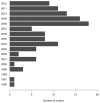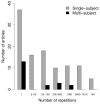A review of fMRI simulation studies
- PMID: 25048024
- PMCID: PMC4105464
- DOI: 10.1371/journal.pone.0101953
A review of fMRI simulation studies
Abstract
Simulation studies that validate statistical techniques for fMRI data are challenging due to the complexity of the data. Therefore, it is not surprising that no common data generating process is available (i.e. several models can be found to model BOLD activation and noise). Based on a literature search, a database of simulation studies was compiled. The information in this database was analysed and critically evaluated focusing on the parameters in the simulation design, the adopted model to generate fMRI data, and on how the simulation studies are reported. Our literature analysis demonstrates that many fMRI simulation studies do not report a thorough experimental design and almost consistently ignore crucial knowledge on how fMRI data are acquired. Advice is provided on how the quality of fMRI simulation studies can be improved.
Conflict of interest statement
Figures





References
Publication types
MeSH terms
LinkOut - more resources
Full Text Sources
Other Literature Sources
Medical

